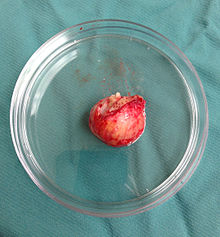Sebaceous cyst
| Sebaceous cyst | |
|---|---|
 | |
| Pronunciation | |
| Specialty | Dermatology,general surgery |
Asebaceous cystis a term commonly used to refer to either:[1]
- Epidermoid cysts(also termed epidermal cysts, infundibular cyst)
- Pilar cysts(also termed trichelemmal cysts, isthmus-catagen cysts)
Both of the above types ofcystscontainkeratin,notsebum,and neither originates fromsebaceous glands.Epidermoid cysts originate in theepidermisand pilar cysts originate fromhair follicles.Technically speaking, then, they are not sebaceous cysts.[2]"True" sebaceous cysts, which originate from sebaceous glands and which contain sebum, are relatively rare and are known assteatocystoma simplexor, if multiple, assteatocystoma multiplex.
Medical professionals have suggested that the term "sebaceous cyst" be avoided since it can be misleading.[3]: 31 In practice, however, the term is still often used for epidermoid and pilar cysts.
Signs and symptoms
[edit]
Thescalp,ears,back,face,andupper arm,are common sites of sebaceous cysts, though they may occur anywhere on the body except the palms of thehandsandsolesof the feet.[4]They are more common in hairier areas, where in cases of long duration they could result inhair losson the skin surface immediately above the cyst. They are smooth to the touch, vary in size, and are generally round in shape.
They are generally mobile masses that can consist of:
- Fibrous tissuesand fluids
- A fatty (keratinous) substance that resemblescottage cheese,in which case the cyst may be called "keratin cyst" - this material has a characteristic "cheesy" orfoot odorsmell
- A somewhat viscous, serosanguineous fluid (containingpurulentand bloody material)
The nature of the contents of a sebaceous cyst, and of its surrounding capsule, differs depending on whether the cyst has ever been infected.
With surgery, a cyst can usually be excised in its entirety. Poor surgical technique, or previous infection leading to scarring and tethering of the cyst to the surrounding tissue, may lead to rupture during excision and removal. A completely removed cyst will not recur, though if the patient has a predisposition to cyst formation, further cysts may develop in the same general area.
Causes
[edit]Cysts may be related to high levels oftestosterone,hence may be more frequent in users ofanabolic steroids.[5]
A case has been reported of a sebaceous cyst being caused by thehuman botfly.[6]
Hereditary causes of sebaceous cysts includeGardner's syndromeandbasal cell nevus syndrome.
Types
[edit]Epidermoid cyst
[edit]Pilar cyst
[edit]About 90% of pilar cysts occur on the scalp, with the remaining sometimes occurring on the face, trunk, and extremities.[7]: 1477 Pilar cysts are significantly more common in females, and a tendency to develop these cysts is often inherited in anautosomal dominantpattern.[7]: 1477 In most cases, multiple pilar cysts appear at once.[7]: 1477
Treatment
[edit]This sectionneeds additional citations forverification.(September 2007) |
Sebaceous cysts generally do not require medical treatment. However, if they continue to grow, they may become unsightly, painful, and/or infected.
Surgical
[edit]Surgicalexcision of a sebaceous cyst is a simple procedure to completely remove the sac and its contents,[8]although it should be performed when inflammation is minimal.[9]

Three general approaches are used - traditional wide excision, minimal excision, and punch biopsy excision.[10]
The typical outpatient surgical procedure for cyst removal is to numb the area around the cyst with alocal anaesthetic,then to use ascalpelto open the lesion with either a single cut down the center of the swelling, or an oval cut on both sides of the center point. If the cyst is small, it may belanced,instead. The person performing the surgery will squeeze out the contents of the cyst, then use blunt-headed scissors or another instrument to hold the incision wide open while using fingers or forceps to try to remove the cyst wall intact. If the cyst wall can be removed in one piece, the "cure rate" is 100%. If, however, it is fragmented and cannot be entirely recovered, the operator may usecurettage(scraping) to remove the remaining exposed fragments, then burn them with anelectrocauterizationtool, in an effort to destroy them in place. In such cases, the cyst may recur. In either case, the incision is thendisinfected,and if necessary, the skin is stitched back together over it. Ascarwill most likely result.
An infected cyst may require oralantibioticsor other treatment before or after excision. If pus has already formed, then incision and drainage should be done along with avulsion of the cyst wall with proper antibiotics coverage.
An approach involvingincision,rather thanexcision,has also been proposed.[11]
References
[edit]- ^"Epidermoid and pilar cysts (previously known as sebaceous cysts)".British Association of Dermatologists.RetrievedApril 2,2014.
- ^"Epidermoid and Pilar Cysts (Sebaceous Cysts) - Patient UK".Retrieved2013-03-04.
- ^Neville BW, Damm DD, Allen CA, Bouquot JE (2002).Oral & maxillofacial pathology(2nd ed.). Philadelphia: W.B. Saunders.ISBN978-0721690032.
- ^"Sebaceous Cysts: Treatment & Cause".Cleveland Clinic.Retrieved2022-02-05.
- ^Scott, MJ; Scott, AM (1992). "Effects of anabolic-androgenic steroids on the pilosebaceous unit".Cutis.50(2): 113–116.PMID1387354.
- ^Harbin LJ, Khan M, Thompson EM, Goldin RD (2002)."A sebaceous cyst with a difference: Dermatobia hominis".J. Clin. Pathol.55(10): 798–9.doi:10.1136/jcp.55.10.798.PMC1769786.PMID12354816.
- ^abcBarnes L, ed. (2008).Surgical pathology of the head and neck(3rd ed.). New York: Informa Healthcare.ISBN978-0849390234.
- ^Klin B, Ashkenazi H (1990). "Sebaceous cyst excision with minimal surgery".American Family Physician.41(6): 1746–8.PMID2349906.
- ^Zuber TJ (2002)."Minimal excision technique for epidermoid (sebaceous) cysts".Am Fam Physician.65(7): 1409–12, 1417–8, 1420.PMID11996426.
- ^Moore RB, Fagan EB, Hulkower S, Skolnik DC, O'Sullivan G (2007). "Clinical inquiries. What's the best treatment for sebaceous cysts?".The Journal of Family Practice.56(4): 315–6.PMID17403333.
- ^Nakamura M (2001). "Treating a sebaceous cyst: an incisional technique".Aesthetic Plastic Surgery.25(1): 52–6.doi:10.1007/s002660010095.PMID11322399.S2CID8354318.
External links
[edit]- Overviewat University of Maryland Medical Center
- Epidermal Inclusion CystateMedicine
